MARIANI’S
Virtual
Gourmet
JUNE 26,
2016
NEWSLETTER
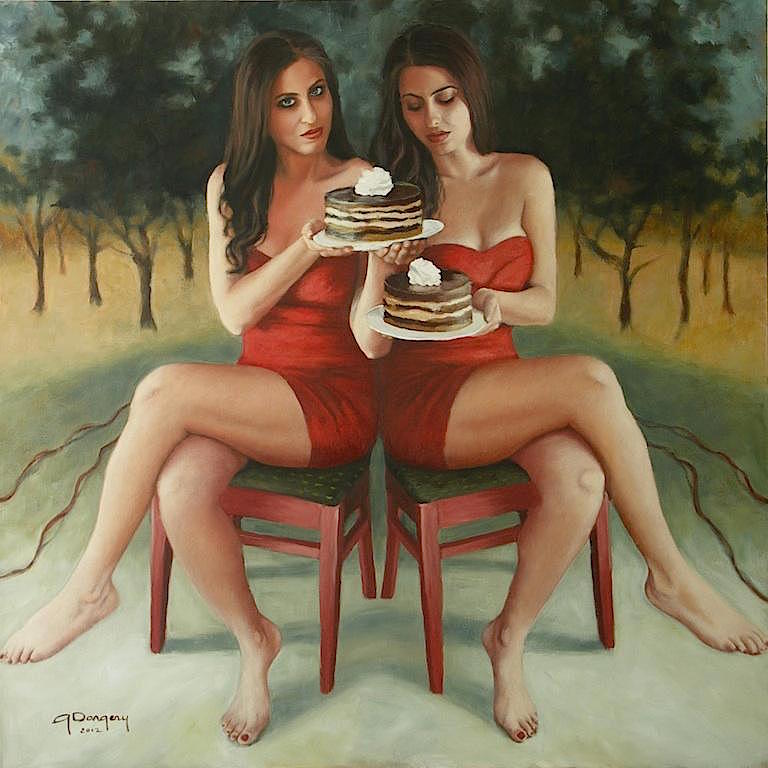
❖❖❖
IN THIS ISSUE
ROME'S HOTELS
Part One
By John Mariani
NEW YORK CORNER
INDIA
By John Mariani
NOTES FROM THE WINE CELLAR
A CRITIQUE OF PURE RIESLING, Part Two
By John A. Curtas
❖❖❖
 VERY
SPECIAL EVENT: On July 7 Lincoln Ristorante at
Lincoln Center in NYC will host a Sugar Snap Pea
Dinner, with
special guest, pioneering botanist and inventor of
the snap pea back in 1979, Calvin Lamborn. Chefs
Marco Canora, Wylie Dufresne, and Justin Smillie
will join Lincoln Chefs Jonathan Benno and Richard
Capizzi to cook a five-course dinner highlighting
the selection of peas. It will be a rare evening
offering guests the chance to taste several
varietals of the peas, and meet the extraordinary
man known as the ‘Snap Pea Sensei.’ 5 Course Dinner
$150 pp. (plus tax and gratuity). Lincoln
Ristorante, 142 West 65th Street;
212.359.6500. http://bit.ly/1UdEtmq
VERY
SPECIAL EVENT: On July 7 Lincoln Ristorante at
Lincoln Center in NYC will host a Sugar Snap Pea
Dinner, with
special guest, pioneering botanist and inventor of
the snap pea back in 1979, Calvin Lamborn. Chefs
Marco Canora, Wylie Dufresne, and Justin Smillie
will join Lincoln Chefs Jonathan Benno and Richard
Capizzi to cook a five-course dinner highlighting
the selection of peas. It will be a rare evening
offering guests the chance to taste several
varietals of the peas, and meet the extraordinary
man known as the ‘Snap Pea Sensei.’ 5 Course Dinner
$150 pp. (plus tax and gratuity). Lincoln
Ristorante, 142 West 65th Street;
212.359.6500. http://bit.ly/1UdEtmq
❖❖❖
ROME'S HOTELS
Part One
By John Mariani
By now the high
season is in full swing in Italy, producing
debilitating crowds and long lines everywhere,
which is why, when traveling anywhere, choosing a
hotel with a eminently knowledgeable concierge can
be crucial in planning your schedule. A good
concierge is not just helpful getting restaurant
reservations, but can wave you away from
particular museums and monuments at certain times
of day when the crowds would be prohibitive.
He may also know of special tickets that allow you
to buck the lines, can arrange for you to have a
driver or how to use the subway in Rome,
which is still (slowly) expanding.
That said, the best concierges
in Rome are in the best hotels, where having such
a job is extremely prestigious and
well-paying. They pride themselves on
quickly making difficult doors open for their
guests, and, as the saying goes, the impossible
takes a little longer. So here are two
of the top hotels in Rome.
ROME CAVALIERI
Via
Alberto Cadlolo 101
011-39-06-3509-1
Romecavalieri.com
Perched high up on Monte Mario,
with a view of the vast city of Rome and the
Vatican, the
Cavalieri was designed as a respite from the
day-time madness below. The comfort of the rooms
ranges from high luxury to eye-popping elegance. All the
rooms are sound proofed, each with a living area,
and with all of the finest amenities, including WiFi
(that really works!); on the top two floors are the
hotel’s grandest Imperial Rooms, with their own
separate check-in and elevator access.
More than
any other hotel I know in Rome, the Cavalieri offers
its own “experiences,” which include children’s
activities and for adults afternoon tea in the
Tiepolo Lounge, with its magnificent 1725 triptych
by the artist. Indeed, the hotel has one of the
world’s finest private art collections dating to the
16th century (right),
including an infant’s crib commissioned by Napoleon for
his son, a coiffeuse table designed for Marie
Antoinette, Bacchanalian frescoes, and the
famously rare Beauvais tapestries. You may arrange
for a private tour of the collection.
There are some fantasy offerings,
including learning gladiatorial combat to satisfy
one’s inner Spartacus, and something more
contemporary:
the chance to rent either a Lamborghini or
Maserati sportscar so you can chase James Bond’s
Aston-Martin around the nightime streets of Rome.
The hotel’s concierge
can also arrange for you to take a 90-minute tour of
the highly restricted Vatican Gardens—the Pope’s own private
walkway—then a further tour of the Vatican Museum,
without enduring the endless lines. The hotel
can also arrange for a round of golf at the Rome
Golf Club, five minutes from city center.
Throughout the day there is a
complimentary hotel shuttle that takes guests down
to stops at the Via Veneto and the Piazza
Barberini; otherwise it's a steep walk down and
back.
THE HASSLER HOTEL
Piazza
Trinità dei Monti, 6
39 06 699340
Hotelhasslerroma.com
In the historic center of
Rome, adjacent to the Spanish Steps, is the
magnificent Hassler Hotel, one of those
once-in-a-lifetime experiences that may well turn
into a habit whenever you visit Rome. For once
you are received and greeted here by Roberto E.
Wirth, President, General Manager and second
generation owner of The Hassler, you will experience
a graciousness and personal concern that marks
everyone’s stay here.
By the time you get to the concierge desk it
seems everyone in the hotel knows you by name.
The Hassler has been in the Wirth
family since 1921.
Just before World War II Oscar Wirth
demolished the original building and, after the war
began, its
replacement would become the Rome headquarters for
the U.S. Air
Force, re-opening to the public in 1947.
Since then, The Hassler has
remained at the top of Rome’s five-star hotels by
maintaining its singular traditions, both
architecturally and hospitality-wise, and its
consistent clientele includes just about every
international movie star and head of state, dating
back to John and Jacqueline Kennedy’s visit to Rome
in July 1963 (left).
There is probably no one in Rome
who is better connected to the international
community of travel than Roberto Wirth (below), who
serves as consultant to other hotels, is active in
many charities, and currently is President
of the Spanish Steps Association; in 2005 he was
named "Independent Hotelier of the World" by Hotels
magazine, and a year later was awarded the Prize for
Economic Achievement by Rome’s City Government and the
"Marco Aurelio Prize for Tourism.” Wirth also has
received several Honorary Doctorates in Humane
Letters, and is one of the eight deaf recipients of
the Deaf Nation Inspiration Award (for Hotel
Hospitality). Two years ago Wirth was awarded the
“Leading Legend Award” by The Leading Hotels of the
World.
I
mention all these honors because in a hotel world
where owners are fickle and general managers come
and go, Wirth has forged and refined his own brand
of style and hospitality so that The Hassler remains
unique in Rome and very rare anywhere else. Aside
from the expected amenities in the rooms, there is
same-day laundry service (tough to find in Rome),
complimentary shoeshine service (rare now
everywhere), a business center, and VIP shuttle
service.
Its spectacular eminence next to
the Trinità del Monti church and the Spanish Steps
gives The Hassler a sense of being in the center of
things—it’s just steps from the Keats-Shelley
Memorial, Via Condotti and Villa Borghese—while
seeming separate from the swirling carousel that is
Rome.
The Wirths also own the smaller
four-room Il Palazzetto (left) astride the Spanish Steps,
which has
the feeling of being its own boutique pied-a-terre,
with access to all The Hassler’s services.
Our room in The Hassler was one
of the more recently updated (below), with a
modern, white-silver-and-black décor, a wonderfully
roomy dressing area and stunning, large marble
bathroom. (I recall the days when bathrooms in Rome,
even at the five-star level, were cramped and
uncomfortable.)
As
with the Cavalieri’s great restaurant, La Pergola, I
will be reporting on The Hassler’s marvelous Imago
terrace dining room in the near future. You may
also dine at the riotously colorful Salone Eva with
its adjacent bar (favored by the late Princess
Diana) or the outdoor Palm Court Garden Restaurant
& Bar. Wherever
you allow yourself to drop after a day of
sightseeing, you’ll feel cushioned against all the
world’s follies and foibles, content to drink a
Martini or Negroni on a tufted banquette in view of
a marble fireplace and bookcases, wondering when
Signore Wirth may come by to greet his old friends
and his new acquaintances, to make sure everything
is being done for your comfort.
As I wrote some years ago on my
last visit to The Hassler, “through its revolving doors has come
the whole world, and the hotel’s concierges perform
more miracles than the Pope, at the
request of guests who are as demanding as they are
eccentric. From your room you can see the
hokey grandeur of the Victor Emmanuel II
monument and the splendor of the Piazza Navona, the cool
greenery of the Borghese Gardens and all the glowing
marble domes of Rome’s churches and St. Peter’s
spread across the horizon.”
At twilight the intense blue
of Rome’s sky softens into a band of pink and fiery
orange punctuated by the city’s steeples and spires.
The lights of Rome’s monuments come up to mimic the
incandescence of the moon, and everyone in the
streets seems in the throes of la dolce vita
until the church bells toll at midnight.
❖❖❖
By John Mariani
INDIA
62 Main Street

New Canaan, CT
203-972-8332
indiaNewCanaan.com
“But this is New Canaan, not Manhattan!”
So say many of
chef/restaurateur Prasad Chirnomula’s customers,
whining about the prices at his superb Indian
restaurant in one of Connecticut’s wealthiest
communities, where the median family income is
$230,000.
“I ask them, why?” says
Chirnomula. “The price of food is the same, my
labor costs are the same, and in New Canaan I’m
paying as much or more for rent.”
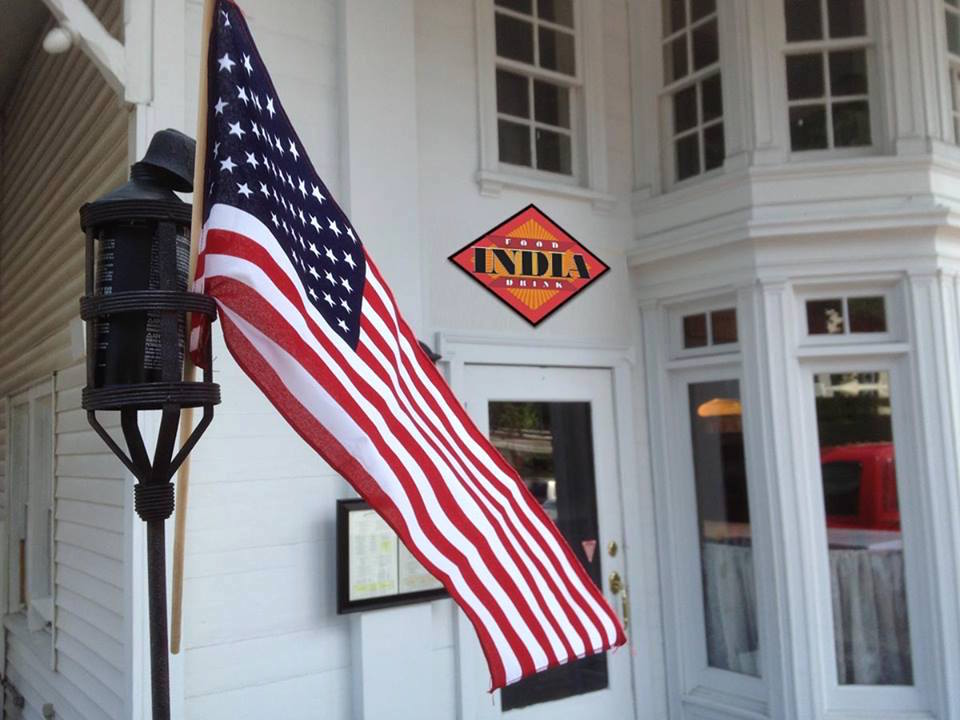
Actually, Chirnomula’s prices
are not high at all—the most expensive dish on the
menu is $28—but it’s not surprising to hear such
comments about Indian restaurants anywhere,
because American diners have come to think of
them, as with so many other ethnic restaurants, as
being cheap eateries and they know that Manhattan
charges the highest prices for everything. This,
despite the fact that so many higher-end Indian
restaurants have moved far from the stereotypical
curry houses of the past, whose gravies vary
little and whose ingredients are not always of the
highest quality.
Modern Indian restaurants in
NYC like Junoon, Awadh, Utsav and Tamarind can
compete in food, service and décor with the best
of any stripe in Manhattan, and, as anyone who
knows even a little about Queens can tell you, the
Indian restaurants there cater very strongly to a
demanding Indian, Pakistani and Bangladeshi
customer base.
Chirnomula
is well aware that his four Connecticut
restaurants may not have the clientele that can
distinguish among the myriad cuisines of India,
but the chef, who is from Hyderabad in the south
of the sub-continent, is committed to changing the
preconceptions among Americans that an Indian menu
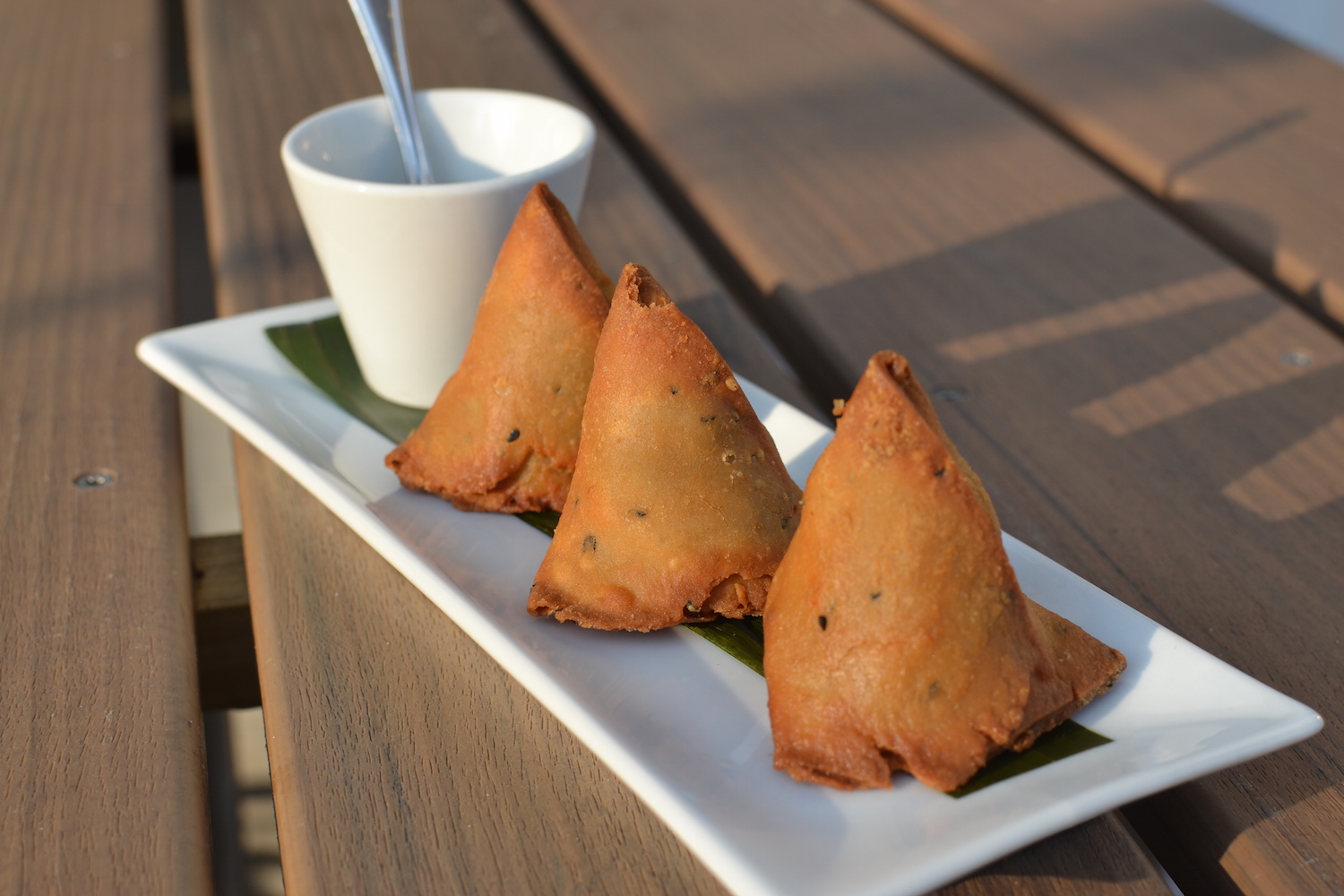 is little more than
tandoori, mulligatawny soup and thirty variations
on curry. His
New Canaan restaurant shares some of the favorite
menu items at his two Thali vegetarian branches in
New Haven and Stamford, drawing on
well-established connections with Hudson Valley
growers for his provender. But in its spaciousness
and décor, and for Chirnomula’s signature dishes
like turmeric and spice marinated salmon (below) with a
creamy dill sauce and beet chips ($28) and Belize
king prawns with ginger cream, red quinoa and
crisp okra ($28), the New Canaan location is his
flagship.
is little more than
tandoori, mulligatawny soup and thirty variations
on curry. His
New Canaan restaurant shares some of the favorite
menu items at his two Thali vegetarian branches in
New Haven and Stamford, drawing on
well-established connections with Hudson Valley
growers for his provender. But in its spaciousness
and décor, and for Chirnomula’s signature dishes
like turmeric and spice marinated salmon (below) with a
creamy dill sauce and beet chips ($28) and Belize
king prawns with ginger cream, red quinoa and
crisp okra ($28), the New Canaan location is his
flagship.
India is located in a splendid
150-year-old building on Main Street that has been
home to several other restaurants. Right
now you may wish to dine al fresco in the pretty
adjacent patio; inside there are three sections: a
small dining room, a bar, and a larger rear dining
room, all of them comfortable enough, except that
the very low lighting plays against very dark
colors of black and brown, accented with a
rose-colored wall band.
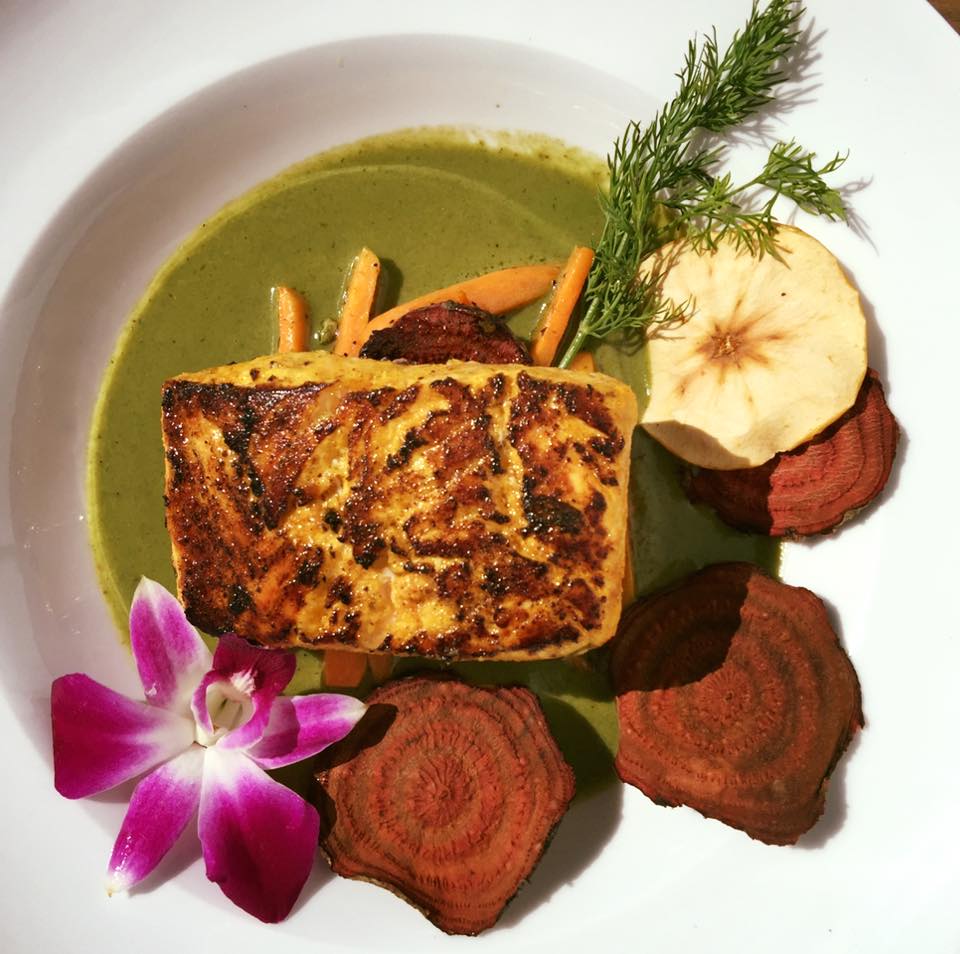 The
service
staff is affable and the food comes out at a
civilized pace.
The
service
staff is affable and the food comes out at a
civilized pace.
The menu is segmented into
vegetarian, signature items, tandoori breads,
kababs, classic fare, and desserts, and our party
chose a wide assortment, beginning with a basket
of mini-breads to be spread with luscious
condiments.
The smoky naans, paratha, and onion kulcha
breads were to follow (any three breads $12),
essential to mop up the rich sauces. Chirnomula
is a subtle master of spicing, revealing layers of
flavor and heat (heat levels may be adjusted on
request), and such delicacy is as evident in a
dish of grilled vegetables tossed in fennel,
fenugreek and nigella seed ($10) as it is in the
plump potato-and-pea-stuffed samosa (above) pastry
triangles ($6).
This approach to subtlety turns
a dish of Konkan crab into a triumph, with a tangy
coconut-lemon sauce and unusual gooseberry patties
($14), as it does with the marinated salmon
dish, not one I’ve run across in any other Indian
restaurant.
The tandoori dishes come out of that fierce
clay oven steaming, but not dried out or blackened
with charring ($19-$24), while the always—and
intentionally—spicy lamb vindaloo ($21) reveals an
array of spices that otherwise might easily get
lost in the heat.
I love savory lentil-based dals,
and here makhni
dal ($8 or $12) is slowly cooked with fresh
ginger and turmeric to turn a lovely yellow-orange
color, which also tints marvelously rich chicken
tikka masala (right;
$17). The
only disappointing dish was shrimp in a classic
spinach sag sauce ($19), which was too bitter and
smothered the
flavor of the crustacean.
the
flavor of the crustacean.
There’s good reason to order
dessert at India, for, unlike so many other
renderings elsewhere,
the rose-water tinged ras malai,
with tapioca pearls for texture, and the kulfi
ice cream were just sweet enough to allow nuances
of flavors to emerge.
India stocks a very long
IPA-dominated beer list (with most bottles and
cans $5-$9), which makes up for a very small wine
list, and about a dozen special cocktails with
names like Goan Spritz and Mumbai Rye.
From how
Chirnomula described his hard work and his frantic
workday, his ability to keep so many restaurants
running in three different Connecticut towns is
owed to consistency and constant attention, which
doesn’t leave much for his golf game or new house. So I
hope he might slow down a little, content that his
long-time concern for guests and hospitality and
his innovative cuisine have been in the vanguard
of changing people’s minds bout Indian food and
Indian restaurants.
Open daily for lunch and dinner.
❖❖❖
A CRITIQUE OF PURE RIESLING, Part Two
By John A. Curtas
 Nineteenth
Century Map of the Saar and Mosel Wine Region
Nineteenth
Century Map of the Saar and Mosel Wine Region
Striking up a conversation
with Sofia Thanisch is one of the easiest things
in the world to do. The owner of Weingut Wwe. Dr.
H. Thanisch, she is the great granddaughter of the
founders and oversees wines made from two of the
greatest vineyards in Germany: the Bernkasteler
Badstube and Berncasteler Doctor. She is also one
of the most charming people in the world of wine,
and an hour or so spent sipping vintages in her
private tasting room in the village of Bernkastel
is something that should be on every oenophile's
bucket list.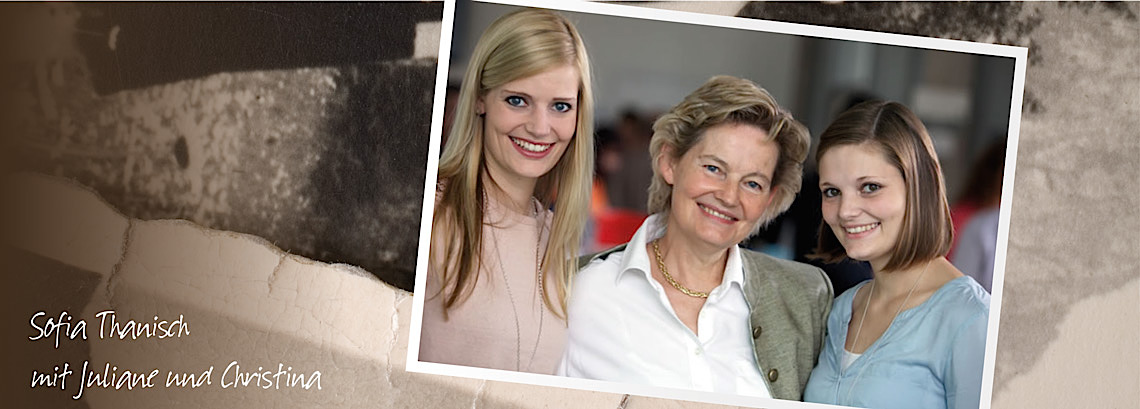
Four generations of women have
controlled this estate (the Wwe. on the label
means "widow"), and Sofia will recount the history
of the weingut (wine estate) and her wine family
(dating back to 1636!) over sips of her entire
catalogue, starting with her entry level Thanisch
label, a wine possessed of a convenient screw-top.
To quote an internet wine seller's tasting notes:
"Yeasty nose, some dried herbs, stone fruit and
some citrus, hint of tobacco and smoked bacon,
tart mineral notes. Sweetish and juicy on the
palate, tart spice, good grip, ripe, polished
fruit, some tobacco, polished, lively acidity,
persistent and has some depth, slightly sandy, but
ripe tannins, yeasty traces, fairly prominent tart
spicy mineral notes, firm grip, fairly creamy,
light vegetal traces on a very good, delicately
sweet finish."
I didn't get all of
that from the bottle, besides the sweetish and
juicy part, tinged with a nice mineral coating and
a touch of herbaceousness, but I will say it's the
type of wine you'd want to quaff with
highly-spiced Thai, Chinese or Korean food, and
will never tire of throughout your meal. All in
all, it's quite a mouthful for a $24 bottle.
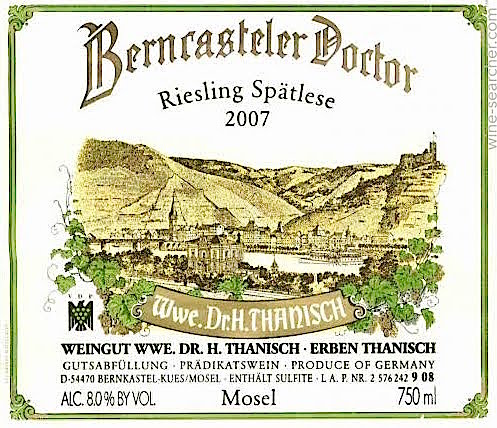 As easy as
it is to fall in love with Thanisch wines,
vigilance is advised when buying them, because, as
if things weren't complicated enough, there are two Dr.
H. Thanisch wineries in the Mosel. One has
labels that look like the one above, except when
it has labels that look like the one above
it. Got that? No one told you this was going
to be easy. But then again, few worthwhile things
in the world are.
As easy as
it is to fall in love with Thanisch wines,
vigilance is advised when buying them, because, as
if things weren't complicated enough, there are two Dr.
H. Thanisch wineries in the Mosel. One has
labels that look like the one above, except when
it has labels that look like the one above
it. Got that? No one told you this was going
to be easy. But then again, few worthwhile things
in the world are.
Back
to Sofia’s wines: Look for the Dr. H.
Thanisch - Erben Thanisch wine label and you'll
always find something ethereal, like Sofia's 2010
Berncasteler Doctor Spätlese ($50), one of
the richest, most precise evocations of the
Riesling grape, all tropical fruits and spicy
complexity, 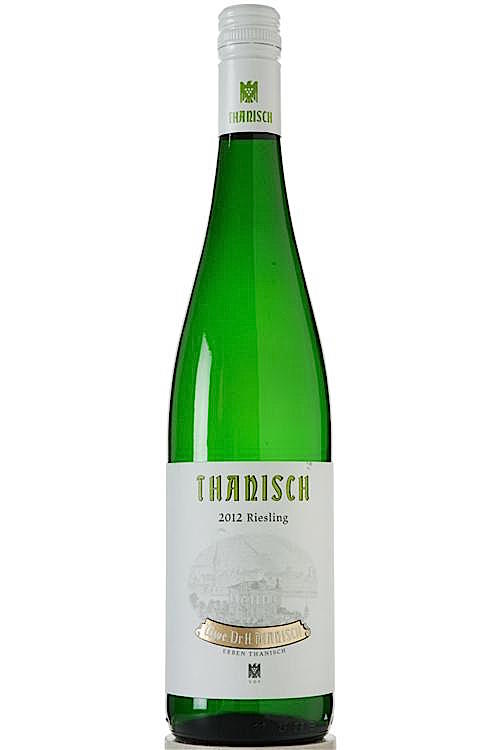 with a
finish that goes on until next Tuesday. When you
consider the flavor punch it packs for around
8%-9% alcohol by volume, you're getting more in
your glass than any Chardonnay you can dream of. Sofia
proudly points to a framed picture on her wall
showing that in 1959 Thanisch wines commanded a
higher price in America than first-growth Bordeaux
and grand cru Burgundies. My how times have
changed.
with a
finish that goes on until next Tuesday. When you
consider the flavor punch it packs for around
8%-9% alcohol by volume, you're getting more in
your glass than any Chardonnay you can dream of. Sofia
proudly points to a framed picture on her wall
showing that in 1959 Thanisch wines commanded a
higher price in America than first-growth Bordeaux
and grand cru Burgundies. My how times have
changed.
If you're nice—and nothing
brings out niceness like glasses of crisp, bracing
Riesling—Sofia may exit the room and return with
bottles so wizened that the labels are a tattered,
unreadable mess. Take it on faith that (at almost
any winery in the world) when rag tag bottles with
moldy labels appear, you know you're in for
something special. In this case we tasted some of
Thanisch's older Auslese labels. These
wines may not be available in stores, but when you
get a sip of a 1996 Berncasteler Doctor Riesling
Auslese , full of pineapple and tropical fruit
aromas, palate-coating creaminess and a long,
deep, shockingly fresh finish, you
will know why people go so nuts over this grape.
And after spending an hour or so with Sofia
Thanisch, you'll be nuts about her as well, and
will have learned that German winemakers are every
bit as friendly and approachable as their wines.
❖❖❖
TIME IT
WOULD BE EVEN MORE OFFAL! 
According to the NY Times, "sausage-wielding
attackers" attacked patrons in a vegan restaurant Kiwi-Cafe
in Tbilisi, Georgia. "It all started when they came
into the cafe speaking and laughing loudly," said the
owner, "and didn't care when we asked them to be quiet
and not to disturb the people who came to watch the
film. . . . [Then] they pulled out some grilled
meat, sausages, fish and started eating them and
throwing them at us, and finally they started to
smoke." According to the restaurant, the
protesters "were neo-Nazis. . .who support fascist
ideas."
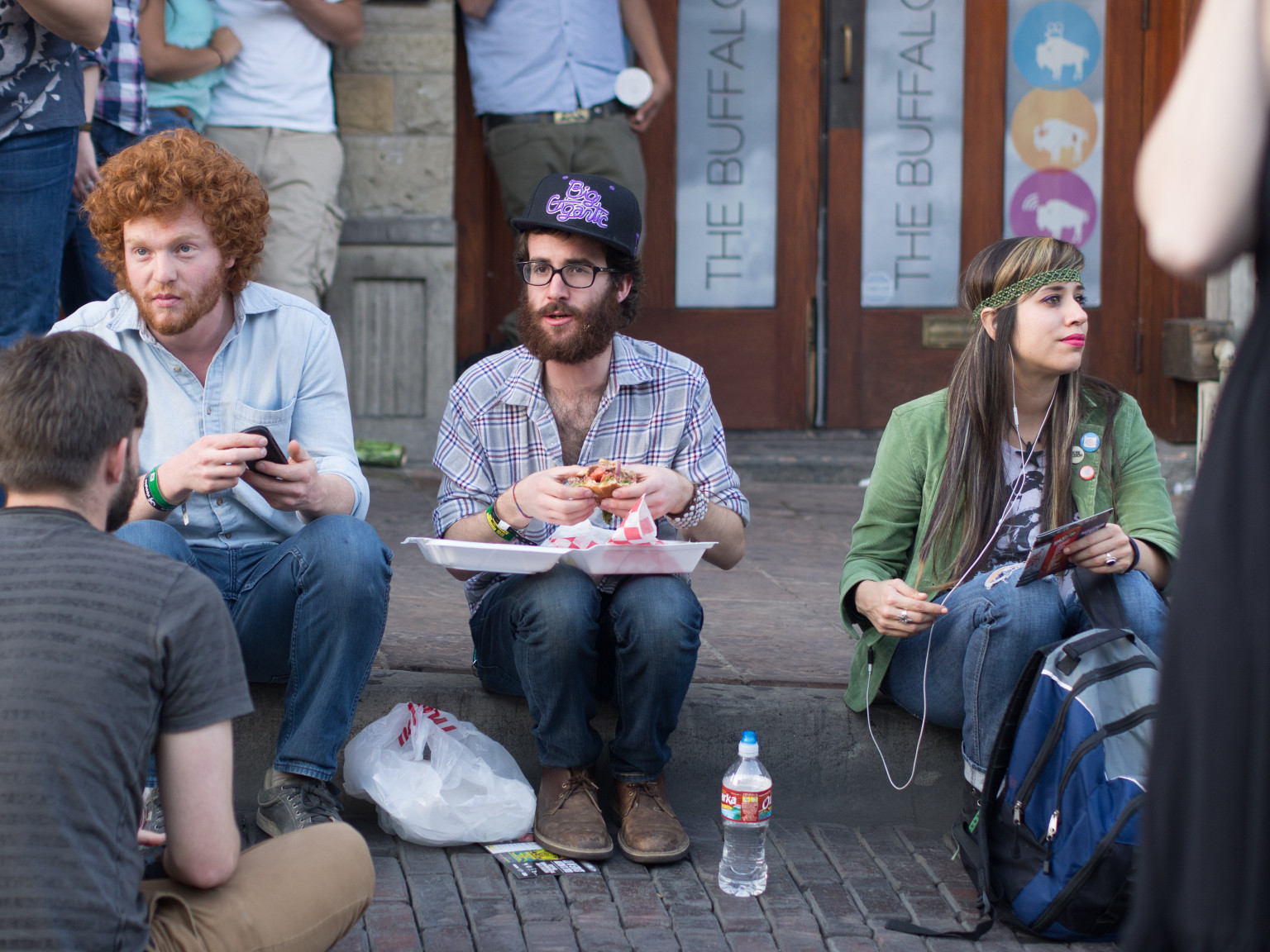 CLEARLY THE HIPSTER RESTAURANT
CLEARLY THE HIPSTER RESTAURANT OF OUR TIME
“On a stormy
Monday night, three twenty-somethings headed west from
their trendy stomping ground of Prospect Heights to
sleepy Park Slope and its Santa Fe Grill, which the Times,
in 1989, named “one of the hot nightspots among the
young and restless.” Ducking in from Seventh Avenue,
they found the Dixie Chicks playing on loop, and the
long cherrywood bar populated by baby boomers who know
where to find a generous serving of Southwestern kitsch,
plus food that an abuelita would make if she
read back issues of Gourmet: crispy Oaxacan
chicken basted in honey-lime butter; charred skirt steak
marinated in basil and chili paste; shrimp enchiladas
made with delicate blue-corn tortillas, a smoky
tomatillo sauce, and fresh Chihuahuan cheese.”—Daniel
Wenger, “Santa Fe Grill,” The New Yorker
(5/9/16)
Any of John Mariani's books below may be ordered from amazon.com.
 The
Hound in Heaven (21st Century Lion Books)
is a novella, and for anyone who loves dogs,
Christmas, romance, inspiration, even the supernatural, I
hope you'll find this to be a treasured favorite.
The story concerns how, after a New England teacher,
his wife and their two daughters adopt a stray puppy found
in their barn in northern Maine, their lives seem full of
promise. But when tragedy strikes, their wonderful dog
Lazarus and the spirit of Christmas are the only things
that may bring his master back from the edge of
despair.
The
Hound in Heaven (21st Century Lion Books)
is a novella, and for anyone who loves dogs,
Christmas, romance, inspiration, even the supernatural, I
hope you'll find this to be a treasured favorite.
The story concerns how, after a New England teacher,
his wife and their two daughters adopt a stray puppy found
in their barn in northern Maine, their lives seem full of
promise. But when tragedy strikes, their wonderful dog
Lazarus and the spirit of Christmas are the only things
that may bring his master back from the edge of
despair. WATCH THE VIDEO!
“What a huge surprise turn this story took! I was completely stunned! I truly enjoyed this book and its message.” – Actress Ali MacGraw
“He had me at Page One. The amount of heart, human insight, soul searching, and deft literary strength that John Mariani pours into this airtight novella is vertigo-inducing. Perhaps ‘wow’ would be the best comment.” – James Dalessandro, author of Bohemian Heart and 1906.
“John Mariani’s Hound in Heaven starts with a well-painted portrayal of an American family, along with the requisite dog. A surprise event flips the action of the novel and captures us for a voyage leading to a hopeful and heart-warming message. A page turning, one sitting read, it’s the perfect antidote for the winter and promotion of holiday celebration.” – Ann Pearlman, author of The Christmas Cookie Club and A Gift for my Sister.
“John Mariani’s concise, achingly beautiful novella pulls a literary rabbit out of a hat – a mash-up of the cosmic and the intimate, the tragic and the heart-warming – a Christmas tale for all ages, and all faiths. Read it to your children, read it to yourself… but read it. Early and often. Highly recommended.” – Jay Bonansinga, New York Times bestselling author of Pinkerton’s War, The Sinking of The Eastland, and The Walking Dead: The Road To Woodbury.
“Amazing things happen when you open your heart to an animal. The Hound in Heaven delivers a powerful story of healing that is forged in the spiritual relationship between a man and his best friend. The book brings a message of hope that can enrich our images of family, love, and loss.” – Dr. Barbara Royal, author of The Royal Treatment.
 |
The Encyclopedia of American Food and Drink by John F. Mariani (Bloomsbury USA, $35) Modesty forbids me to praise my own new book, but let me proudly say that it is an extensive revision of the 4th edition that appeared more than a decade ago, before locavores, molecular cuisine, modernist cuisine, the Food Network and so much more, now included. Word origins have been completely updated, as have per capita consumption and production stats. Most important, for the first time since publication in the 1980s, the book includes more than 100 biographies of Americans who have changed the way we cook, eat and drink -- from Fannie Farmer and Julia Child to Robert Mondavi and Thomas Keller. "This book is amazing! It has entries for everything from `abalone' to `zwieback,' plus more than 500 recipes for classic American dishes and drinks."--Devra First, The Boston Globe. "Much needed in any kitchen library."--Bon Appetit. |
"Eating Italian will never be the same after reading John Mariani's entertaining and savory gastronomical history of the cuisine of Italy and how it won over appetites worldwide. . . . This book is such a tasteful narrative that it will literally make you hungry for Italian food and arouse your appetite for gastronomical history."--Don Oldenburg, USA Today. "Italian
restaurants--some good, some glitzy--far
outnumber their French rivals. Many of
these establishments are zestfully described
in How Italian Food Conquered the World, an
entertaining and fact-filled chronicle by
food-and-wine correspondent John F.
Mariani."--Aram Bakshian Jr., Wall Street
Journal.
"Equal parts
history, sociology, gastronomy, and just
plain fun, How Italian Food Conquered the
World tells the captivating and delicious
story of the (let's face it) everybody's
favorite cuisine with clarity, verve and
more than one surprise."--Colman Andrews,
editorial director of The Daily
Meal.com. "A fantastic and fascinating
read, covering everything from the influence
of Venice's spice trade to the impact of
Italian immigrants in America and the
evolution of alta cucina. This book will
serve as a terrific resource to anyone
interested in the real story of Italian
food."--Mary Ann Esposito, host of PBS-TV's
Ciao
Italia. "John Mariani has written the
definitive history of how Italians won their
way into our hearts, minds, and
stomachs. It's a story of pleasure over
pomp and taste over technique."--Danny Meyer,
owner of NYC restaurants Union Square
Cafe, The Modern, and Maialino.
|
 |
 |
 |
 |
 |
 |
 |
 |
 Everett Potter's Travel Report:
Everett Potter's Travel Report: 
 Eating Las Vegas
JOHN CURTAS has been covering the Las Vegas
food and restaurant scene since 1995. He is
the co-author of EATING LAS VEGAS – The 50
Essential Restaurants (the fourth
edition of which will be published in early
2016), as well as the author of the Eating Las
Vegas web site: www.eatinglasvegas.
He can also be seen every Friday morning as
the “resident foodie” for Wake Up With the
Wagners on KSNV TV (NBC) Channel 3 in
Las Vegas.
Eating Las Vegas
JOHN CURTAS has been covering the Las Vegas
food and restaurant scene since 1995. He is
the co-author of EATING LAS VEGAS – The 50
Essential Restaurants (the fourth
edition of which will be published in early
2016), as well as the author of the Eating Las
Vegas web site: www.eatinglasvegas.
He can also be seen every Friday morning as
the “resident foodie” for Wake Up With the
Wagners on KSNV TV (NBC) Channel 3 in
Las Vegas.

MARIANI'S VIRTUAL GOURMET
NEWSLETTER is published weekly. Editor/Publisher: John
Mariani.
Editor: Walter Bagley. Contributing Writers: Christopher Mariani,
Robert Mariani, Misha
Mariani,
John A. Curtas, Edward Brivio, Mort Hochstein,
Andrew Chalk, Dotty Griffith and Brian Freedman. Contributing
Photographers: Galina Dargery, Bobby
Pirillo. Technical Advisor: Gerry McLoughlin.
To un-subscribe from this newsletter,click here.
© copyright John Mariani 2016

